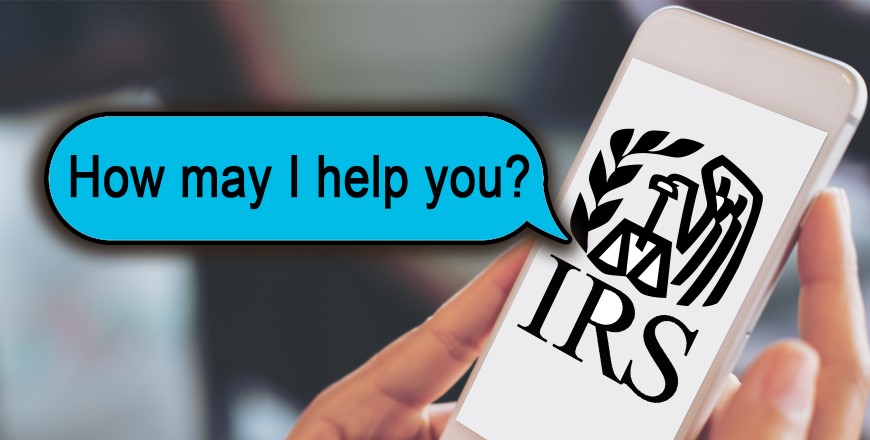Using voice and chat bots to improve the collection taxpayer experience
Get to know the IRS, its people and the issues that affect taxpayers.
By Darren Guillot, IRS Small Business/Self-Employed Deputy Commissioner
CL-22-14, September 29, 2022
Taxpayer service remains a top IRS priority, and we recently put in place some new technology involving voice and chat bots to help make it easier for people to get the help they need.
Just like everyone else, if I call a business, I hate to be kept on hold when I need assistance or have a question. For example, in the case of the IRS, a taxpayer may have a question about a notice – or letter – they received or are looking to pay their taxes but can’t get through to anyone to assist them.
So today, I’d like to talk about how the IRS has improved the taxpayer experience and level of service through chat and voice bots. Many taxpayers interact with the IRS through our employees – called Contact Representatives – that work in our Automated Collection System. Contact Representatives are our telephone assistors, the ones who answer taxpayer telephone calls. In 2014, Collection’s service level was about 70%, but it dropped to about 38% by 2021. The drop was due to resource challenges related to a series of necessary business realignments and significantly increased call volumes from inquiries about the Economic Impact Payments and the Advance Child Tax Credit payments.
To help address this, in 2020, the Small Business/Self Employed Division’s Collection and Operations Support (in collaboration with IRS Information Technology) were tasked with building a proof of concept and business requirements needed to use voice and chat bots. The goal was to increase self-service capabilities for general taxpayer inquiries so that people with more complex issues could get through to live assistors on the phone. In 2021, we received the necessary funding to implement taxpayer-facing voice and chat bot self-assist solutions in English and Spanish.
Chat bots simulate human conversation through web-based text interaction using artificial intelligence-powered software to respond to natural language prompts. Our first chat bot used by the Collection division began in December 2021 on the IRS.gov payments page to provide taxpayers with self-service assistance for common questions. Since that chat bot launched, it has handled more than 450,000 interactions, and 42% of those interactions were resolved without being escalated to an ACS phone assistor. In theory, that means that 42% of these visitors at IRS.gov got what they needed without needing help from a live chat assistor. I say in theory because a small percentage of callers may have chosen to disconnect from the self-assist process. We always want to ensure taxpayers have that option.
Building upon the success of the chat bot, the IRS deployed the first Collection voice bot in January 2022. Voice bots are software powered by artificial intelligence that allow a caller to navigate an interactive voice response system. The benefit of the voice bot is that it acts a bit like a customer service first responder to quickly answer common questions and help free up phone assistors to concentrate on more complex inquiries. The voice bot answers taxpayer inquiries about making payments, Collection notices and general Collection issues. These are making a difference. These voice bots have handled more than 4.8 million calls since they were deployed, and 40% were contained within the voice bot without the need to escalate to a live assistor.
The initial voice and chat bots were unauthenticated bots, meaning that it wasn’t necessary for the caller to authenticate themselves to get assistance. In June 2022, the IRS deployed an authenticated voice bot. The authenticated voice bot uses cloud-based natural language processing technology for conversational phone applications that fits together with the current IRS integrated voice response systems. It provides a quick and secure way for taxpayers to prove they are really the taxpayer. This authenticated voice bot allows taxpayers to create and manage installment agreements to pay their taxes through self-service applications. June was picked for the go-live date for these bots to coincide with the peak notice season – involving our largest volume of CP14 balance due notices -- to contribute to better levels of taxpayer service.
Approximately five million taxpayers are eligible to use this new technology. They can authenticate and set up or modify short-term (up to 180 days) and long-term payment plans. In addition, users with a current payment plan may be able to make changes including revising payment amounts and/or changing payment dates. In August 2022, we added the ability for users to request account transcripts and find out where to send tax returns and payments. Just since June 14, 2022, these authenticated voice bots have handled more than 1 million calls and created, modified or extended about 7,600 installment agreements worth over $50 million in balances due. The most recent enhancement, on September 28, 2022, includes allowing taxpayers to hear their account/payment history and obtain the current balance owed.
Finally, through August 2022, the combination of unauthenticated and authenticated bots handled over 5.6 million calls, without having to wait on hold! Combined with calls answered by our live ACS assistors, we were able to increase the number of calls answered by 30% since the end of October 2021.
The initial estimate for delivery of this new functionality was 2024 but working closely with our partners in IRS’ Information Technology (IT) on the urgency of this customer need, the experts in IT found a way to deliver it two years ahead of schedule. Now that is focus on the experience of our customers. These innovations will help the IRS provide the level of service taxpayers deserve. As we move forward, we are committed to continue identifying ways to make tax processes more efficient and useful for all taxpayers.
Darren Guillot
IRS Small Business/Self-Employed Deputy Commissioner
About the author
As the Deputy Commissioner, Small Business/Self Employed (SB/SE) Collection and Operations Support, Darren leads the development and delivery of an IRS-wide, comprehensive tax administration program to meet the needs of all America's taxpayers with past due balances and/or unfiled returns. These taxpayers include large and small businesses, tax exempt and government entities, self-employed individuals, wage earners, and those with international interests. Darren also has leadership and oversight of the IRS’ Office of Fraud Enforcement, ensuring agency-wide support in detection and deterrence of tax fraud.
구독
국세청은 다양한 세금 주제에 관한 여러 가지 전자 뉴스 구독을 제공합니다. 새 콘텐츠가 게시될 때 이메일 알림을 받으려면 구독(영어)하세요.
자세히 보기
납세자와 세금 커뮤니티가 관심을 갖는 다양하고 시의적절한 관심사들에 대한 모든 게시물을 읽어보세요 (영어).

 )
또는 https:// 는 안전하게 .gov 웹사이트에 접속했다는 뜻입니다. 오직 공식, 보안 웹사이트 상에서만 민감한 정보를 공유하십시오.
)
또는 https:// 는 안전하게 .gov 웹사이트에 접속했다는 뜻입니다. 오직 공식, 보안 웹사이트 상에서만 민감한 정보를 공유하십시오.



